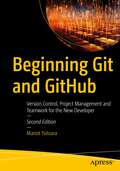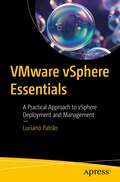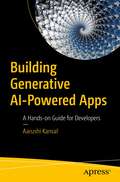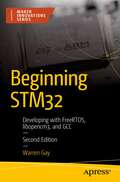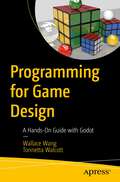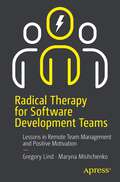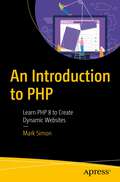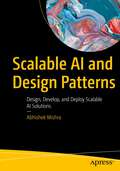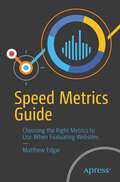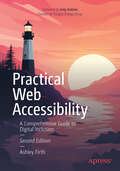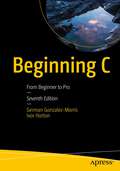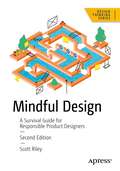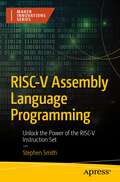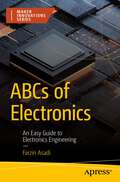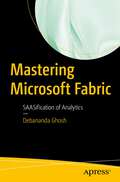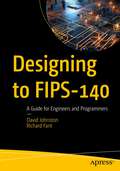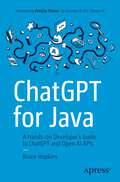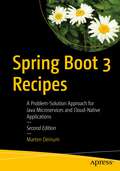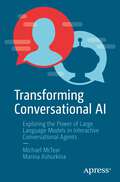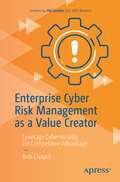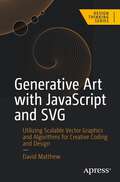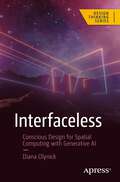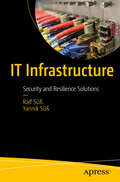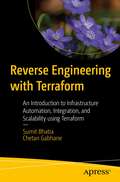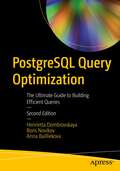- Table View
- List View
Beginning Git and GitHub: Version Control, Project Management and Teamwork for the New Developer
by Mariot TsitoaraLearn the fundamentals of version control through step-by-step tutorials that will teach you the ins-and-outs of Git. This updated version introduces Github workflows, and contains new chapters on how to make Git and GitHub truly yours, covers additional common problems and how to solve them, along with new features of Github pull requests. Divided into three parts – Version Control, Project Management and Teamwork – this book reveals what waits for you in the real world and how to resolve the problems you may run into. Once past the basics of Git, you'll see how to manage a software project, and finally how to utilize Git and GithHub to work effectively as a team. You'll examine how to plan, follow and execute a project with GitHub, and then apply those concepts to real-world situations. Workaround the pitfalls that most programmers fall into when driving a project with Git by using proven tactics to avoid them. You will also be taught the easiest and quickest ways to resolve merge conflicts. A lot of modern books on Git don’t go into depth about non-technical topics. Beginning Git and GitHub is your complete guide to how Git and GitHub work in a professional team environment and will help you cover all the bases right at the start of your career. What You'll Learn Review basic and advanced concepts of GitApply Project Management skills using GitHub Solve conflicts or, ideally, avoid them altogether Use advanced concepts for a more boosted workflow Who This book Is For New developers, developers that have never worked in a team environment before, developers with basic knowledge of Git or GitHub, or anyone who works with text documents.
VMware vSphere Essentials: A Practical Approach to vSphere Deployment and Management
by Luciano PatrãoThis book fills a vacuum in the market for high-quality information on a VMware vSphere system and offers a thorough introduction to VMware virtualization. Written for novices and those seeking more information about vSphere, this book walks you through its key concepts and technology, such as vSphere infrastructure creation, maintenance, and performance for beginners and advanced users.You'll take a step-by-step approach to guarantee you grasp the fundamental concepts and practical procedures required to construct and manage virtual machines in a VMware vSphere system. You'll explore the key components of vSphere with detail and explanation for each feature, including the hypervisor, networking, storage, and high availability, unravelling their intricacies and highlighting best practices.This book provides full VMware knowledge to develop, set up, and maintain vSphere environments that meet modern computing needs. It also features advanced topics, such as resource optimization, performance monitoring, advanced settings, and automation, empowering you to take your virtualization skills to the next level. VMware vSphere Essentials uses a unique step-by-step instructions designed to provide a high-level understanding, accompanied by illustrative images. What You'll LearnEnhance network efficiency with advanced vSphere LACP setupConfigure and manage virtual machines in vSphereImplement vSphere networking and storage Explore advanced vSphere features, such as DRS, HA, and fault toleranceMaster seamless VM migration techniquesOptimize hardware utilization with direct path I/O passthroughWho This Book Is ForSystem administrators, advanced vSphere administrators, and IT professionals pursuing VMware certifications
Building Generative AI-Powered Apps: A Hands-on Guide for Developers
by Aarushi KansalGenerative AI has gone beyond the responsibility of researchers and data scientists and is being used by production engineers. However, there is a lot of confusion where to get started when building an end-to-end app with generative AI. This book consolidates core models, frameworks, and tools into a single source of knowledge. By providing hands-on examples, the book takes you through the generative AI ecosystem to build applications for production.The book starts with a brief and accessible introduction to transformer models before delving into some of the most popular large language models and diffusions models (image generation). These models are the foundations of both AI and your potential new apps. You will then go through various tools available to work with these models, starting with Langchain, a framework to develop foundational models, which is the next building block you should grasp after understanding generative AI models. The next chapters cover databases, caching, monitoring, etc., which are the topics necessary to build larger-scale applications. Real-world examples using these models and tools are included.By the end of this book, you should be able to build end-to-end apps that are powered by generative AI. You also should be able to apply the tools and techniques taught in this book to your use cases and business.What You Will LearnWhat is Generative AI?What is ChatGPT and GPT4?What are language models and diffusions models?How do we deploy LangChain and HuggingFace?Who This Book Is ForSoftware engineers with a few years of experience building applications in any language or infrastructure
Beginning STM32: Developing with FreeRTOS, libopencm3, and GCC (Maker Innovations Series)
by Warren GaySee how using FreeRTOS and libopencm3 instead of the Arduino software environment will help you develop multi-tasking applications that go beyond Arduino norms. This updated version includes expanded coverage of software setup for Windows 10 and 11, additional TM32 hardware capabilities, including clear explanations of "totem pole outputs" versus "open drain outputs," and a new section on project showcasing an interrupt-driven approach for processing USART data.Each chapter contains clear explanations of the STM32 hardware capabilities to help get you started with the device, including GPIO and several other ST Microelectronics peripherals like USB and CAN bus controller. You’ll learn how to download and set up the libopencm3 + FreeRTOS development environment, using GCC. With everything set up, you’ll leverage FreeRTOS to create tasks, queues, and mutexes. You’ll also learn to work with the I2C bus to add GPIO using the PCF8574 chip. And how to create PWM output for RC control using hardware timers.You'll be introduced to new concepts that are necessary to master the STM32, such as how to extend code with GCC overlays using an external Winbond W25Q32 flash chip. Your knowledge is tested at the end of each chapter with exercises. Upon completing this book, you’ll be ready to work with any of the devices in the STM32 family. Beginning STM32, Second Edition provides the professional, student, or hobbyist a way to learn about ARM without costing an arm!What You'll Learn Initialize and use the libopencm3 drivers and handle interruptsUse DMA to drive a SPI based OLED displaying an analog meterRead PWM from an RC control using hardware timersUnderstand STM32 capabilities, including USB controller, RTC, DMA, CAN bus, and more Who This Book Is ForExperienced embedded engineers, students, hobbyists and makers wishing to explore the ARM architecture, going beyond Arduino limits.
Programming for Game Design: A Hands-On Guide with Godot
by Wallace Wang Tonnetta WalcottCreate video game elements using the Godot game engine, gaining practical experience in programming and video game development. The Godot game engine uses a simplified programming language called GDScript, which closely resembles Python. By learning GDScript, you can focus more on learning the basics of programming. You’ll explore concepts such as variables and data structures variables used to store information about video game objects that can be manipulated using a keyboard or a mouse. You’ll also learn about user interface design, branching statements, and looping statements, enabling you to actively engage in programming and create your own interactive games. By the end of the book, you’ll have a solid understanding of how video game elements work and how the basic principles of programming work as well. By programming simple video game elements in the Godot game engine, you’ll learn both programming and the principles of 2D video game design.What You Will LearnUnderstand the basics of programming by creating simple video game elements in the Godot game engine.Explore variables and data structures to actively store and modify information about video game objects.Gain a deeper understanding of user interface design.Master simplified programming languages like GDScript.Who This Book Is For Aspiring programmers and game enthusiasts seeking an engaging introduction to programming through video game creation.
Radical Therapy for Software Development Teams: Lessons in Remote Team Management and Positive Motivation
by Gregory Lind Maryna MishchenkoBuild and maintain effective, collaborative, and motivated software development teams. This book addresses the challenges in doing so, like communication gaps, trust issues, and motivation problems, and provides strategies to overcome them. You'll be introduced to the Radical Therapy Dev philosophy, a holistic approach designed to optimize software development teams for better performance and overall well-being. This book highlights common pain points in software development and offers solutions to resolving much of the issues in teams. It offers strategies for implementation, focusing on adaptability and accountability, while also promoting community-supported standards. And, the book reveals why an emphasis on fostering a growth mindset, mentorship programs, and junior-intern initiatives promotes continuous learning and collaboration.With the rise of remote work, you'll see why hiring globally while thinking locally is gaining popularity. You'll also gain insights into removing barriers to remote work, along with tools and policies for remote collaboration. Additionally, the book explores the concept of cloud-native software development and its benefits. Radical Therapy for Software Development Teams critiques the traditional "agile" methodology, identifying its shortcomings while extracting valuable lessons that can still be applied effectively. What You Will LearnAddress communication gaps, foster trust, and nurture a growth mindset among team membersAvoid common feedback mistakes, recognize accomplishments, and implement a reward systemImprove software development practices and team dynamics Take a scientific approach to project management rather than traditional requirements gatheringBreak Down Communication BarriersWho This Book is ForSoftware development professionals
An Introduction to PHP: Learn PHP 8 to Create Dynamic Websites
by Mark SimonUse PHP to enhance your web pages. This book shows you how PHP programming works, and how to write and organize PHP code. The book starts with steps to download and install a setup for a sample website that will form the basis for upcoming chapters. You start by writing PHP code and learn how to mix it with HTML and manage the code. From there, you will learn about dynamic content, along with a deep dive into form processing and sending email. Saving uploaded data and uploading files is discussed next. You will learn how to configure your PHP project and develop a library. You will then learn how to create an image catalog and manage data on your web page. By the end of the book, you will understand how to work with cookies, sessions, and logging in, followed by an example of creating a simple blog that reiterates the concepts developed in the previous chapters.After reading this book, you will be able to configure, create, and manage your dynamic website.What Will You LearnKnow the basics of programming with the PHP languageUse PHP to generate dynamic web pagesWork with SQL databasesWork with forms to upload text data and binary filesUse tips and tricks to write clean and maintainable codeWho This Book Is ForWeb developers and students learning to develop and maintain PHP code on their website
Scalable AI and Design Patterns: Design, Develop, and Deploy Scalable AI Solutions
by Abhishek MishraUnderstand and apply the design patterns outlined in this book to design, develop, and deploy scalable AI solutions that meet your organization's needs and drive innovation in the era of intelligent automation.This book begins with an overview of scalable AI systems and the importance of design patterns in creating robust intelligent solutions. It covers fundamental concepts and techniques for achieving scalability in AI systems, including data engineering practices and strategies. The book also addresses scalable algorithms, models, infrastructure, and architecture considerations. Additionally, it discusses deployment, productionization, real-time and streaming data, edge computing, governance, and ethics in scalable AI. Real-world case studies and best practices are presented, along with insights into future trends and emerging technologies.The book focuses on scalable AI and design patterns, providing an understanding of the challenges involved in developing AI systems that can handle large amounts of data, complex algorithms, and real-time processing. By exploring scalability, you will be empowered to design and implement AI solutions that can adapt to changing data requirements.What You Will LearnDevelop scalable AI systems that can handle large volumes of data, complex algorithms, and real-time processingKnow the significance of design patterns in creating robust intelligent solutionsUnderstand scalable algorithms and models to handle extensive data and computing requirements and build scalable AI systemsBe aware of the ethical implications of scalable AI systemsWho This Book Is ForAI practitioners, data scientists, and software engineers with intermediate-level AI knowledge and experience
Speed Metrics Guide: Choosing the Right Metrics to Use When Evaluating Websites
by Matthew EdgarFaster websites offer a better user experience and typically have higher conversion rates. It can be challenging to know where to invest to meaningfully improve a website's speed. Investing correctly to improve speed starts with understanding how to correctly measure speed and knowing how to use those measurements to identify the biggest opportunities. Speed Metrics Guide helps marketers, SEOs, business leaders, designers, and everybody else involved in website performance select the right metrics to use to optimize their website's speed. Each chapter examines a specific metric, discusses what it measures, why the metric matters and what tactics will help improve that metric. What You'll LearnThe best metrics and tools to help you measure website speed, including Google's Core Web VitalsHow and when to best use each metricWhere each metric fits within the website loading processHow to use each metric to find different ways of improving website speed Who This book Is ForNon-technical audience, including marketers, SEOs, designers, and UX professionals.
Practical Web Accessibility: A Comprehensive Guide to Digital Inclusion
by Ashley FirthEveryone deserves to use the Internet. An estimated 1.3 billion people experience significant disability. That’s 16percent of the world’s population, or one in six of us. At the same time, over 96 percent of the one million most popular websites have an accessibility issue. Add to this the massive rise in legal cases around sites not being accessible, including Beyoncé, Disney, and Netflix, and you have an important topic that more and more people are starting to engage with.In this updated and revamped second edition of the Amazon technology chart-topping Practical Web Accessibility, you’ll be guided through a broad range of disabilities and access needs. You’ll understand the ways these users typically engage with the web, the barriers they often face, and practical advice on how your websites and content can be compliant, but more than that, inclusive and enjoyable to use. There’s also a new chapter on “Outsourcing Accessibility,” exploring third party “bolt-on” tools, “build your own website” platforms like Wix, and popular design systems. You‘ll explore whether they’re helpful or detrimental in the fight to make the web more accessible.Throughout this book you’ll learn to test for, spot, and fix web accessibility issues for a wide range of physical and mental impairments. Featuring content from the latest compliance frameworks, including the newly released WCAG 2.2 and exploratory concepts in WCAG 3, you’ll see how to go beyond the basic requirements in order to help your users. You’ll also learn that an accessible approach won’t just help people with disabilities, it will improve your website for everyone.This book comes complete with practical examples you can use in your own sites, along with a brand-new approach to auditing and improving a website’s accessibility, and a team’s approach to it, based on tools created by the author and refined over years as a consultant — The FAIR framework and ACCESS checklist. With these tools, you can set up processes for yourself and your team that will drastically improve the accessibility of your sites and, importantly, keep them that way in the future. Suitable for those of any profession or experience level, Practical Web Accessibility gives you all the information you need to ensure that your sites are truly accessible for the modern, inclusive web. If you would like to learn about web accessibility in a clear and actionable way, this book is for you.What You Will LearnA greater understanding of a vast range of disabilities that have online access needs, and the issues they typically face accessing content online.Ways to apply the practical steps required to cater for those needs.How to take your sites, and colleagues, on a journey from being inaccessible to accessible.The importance of accessibility in your designs, code, content, and more.The best ways to test andimprove your sites, so you can be compliant, and truly accessible. Who This Book Is For Anyone, regardless of what they do, who wants to learn how to make websites and their content more accessible for those with disabilities. In the world of web, the book has been used by front and backend developers, designers, product and project managers, team and business leaders.
Beginning C: From Beginner to Pro
by German Gonzalez-Morris Ivor HortonLearn how to program using C, beginning from first principles and progressing through step-by-step examples. This seventh edition is fully updated to reflect new features of C23, and addresses deprecated functions and features that are no longer supported.You’ll discover that C is a foundation language that every programmer ought to know. Beginning C is written by renowned author Ivor Horton and expert programmer German Gonzalez-Morris. This book increases your programming expertise by guiding you through the development of fully working C applications that use what you've learned in a practical context. Examples of how to use deprecated functions are also provided, along with new examples for replacing them when a simple solution is possible.By the end of the book you'll be confident in your skills with all facets of the widely-used and powerful C language and be able to strike out on your own by trying the exercises included at the end of each chapter. All you need are this book and any of the widely available C compilers, and you'll soon be writing real C programs. What You Will Learn Discover the C programming languageProgram using C starting with first steps, then making decisionsUse loops, arrays, strings, text, pointers, functions, I/O, and moreCode applications with strings and textStructure your programs efficientlyWork with data, files, facilities, and more Who This Book Is For Those new to C programming who may or may not have some prior programming experience.
Mindful Design: A Survival Guide for Responsible Product Designers (Design Thinking)
by Scott RileyLearn to create seamless designs backed by a responsible understanding of the human mind. This new edition is fully updated and reworked to employ a realistic, challenging, and practical approach to interface design, presenting state of the art scientific studies in behavioral sciences, interface design and the psychology of design. All with modern, up-to-date examples and screenshots. The practical portion of this edition has been completely reworked, giving you the chance to follow along with a real, proven design process that has produced several successful products imbued with the principles of mindful, responsible design.You'll examine how human behavior can be used to integrate your product design into lifestyle, rather than interrupt it, and make decisions for the good of those that are using your product. You will also learn about the neurological aspects and limitations of human vision and perception; about our attachment to harmony and dissonance; and about our brain’s propensity towards pattern recognition and how we perceive the world around us. In the second half of the book, you’ll follow along with the key phases of a design project, implementing what you have learned in an end-to-end, practical setting. Design is a responsibility, but not enough designers understand the human mind or the process of thought. Mindful Design, Second Edition introduces the areas of brain science that matter to designers, and passionately explains how those areas affect each human’s day-to-day experiences with products and interfaces, providing a battle-tested toolkit to help you make responsible design decisions. What You'll Learn Review how attention and distraction work and the cost of attentional switchingUse Gestalt principles to communicate visual groupingEnsure your underlying models make sense to your audienceUse time, progression, and transition to create a compositionCarefully examine controlling behavior through reductionist and behaviorist motivation concepts Apply the theoretical knowledge to practical, mindful interface design Who This Book Is For The primary audience for this book is professional designers who wish to learn more about the human mind and how to apply that to their work. The book is also useful for design-focused product owners and startup founders who wish to apply ethical thinking to a team, or when bootstrapping their products. The secondary audience is design students who are either studying a ‘traditional’ visual design course, or a UX/interaction design course who have a desire to learn how they might be able to apply mindful design to their early careers. Finally, a tertiary audience for this book would be tutors involved in teaching design, or peripheral, courses who may wish to incorporate its teachings into their lectures, workshops or seminars.
RISC-V Assembly Language Programming: Unlock the Power of the RISC-V Instruction Set (Maker Innovations Series)
by Stephen SmithGain the skills required to dive into the fundamentals of the RISC-V instruction set architecture. This book explains the basics of code optimization, as well as how to interoperate with C and Python code, thus providing the starting points for your own projects as you develop a working knowledge of assembly language for various RISC-V processors.The RISC-V processor is the new open-source CPU that is quickly gaining popularity and this book serves as an introduction to assembly language programming for the processor in either 32- or 64-bit mode. You’ll see how to write assembly language programs for several single board computers, including the Starfive Visionfive 2 and the Espressif ESP32-C3 32-bit RISC-V microcontroller. The book also covers running RISC-V Linux with the QEMU emulator on and Intel/AMD based PC or laptop and all the tools required to do so.Moving on, you’ll examine the basics of the RISC-V hardware architecture, all the groups of RISC-V assembly language instructions and understand how data is stored in the computer’s memory. In addition, you’ll learn how to interface to hardware such as GPIO ports. With RISC-V Assembly Language Programming you’ll develop enough background to use the official RISC-V reference documentation for your own projects.What You'll LearnProgram basic RISC-V Assembly LanguageSee how data is represented and stored in a RISC-V based computerMake operating system calls from Assembly Language and include other software libraries in projectsInterface to various hardware devicesComprehend code containing Assembly LanguageReverse engineer and hack codeUse the official RISC-V reference documentationWho This Book Is ForThose who have already learned to program in a higher-level language like Python, Java, C# or even C and now wish to learn Assembly Language programming.
ABCs of Electronics: An Easy Guide to Electronics Engineering (Maker Innovations Series)
by Farzin AsadiLearn the fundamental principles of electronic components in a simple, easy-to-follow text. This book is a must-have for anyone seeking to master the basics of electronic engineering.Completely avoiding unnecessary complex technical concepts and highly mathematical terms, chapters are presented in simple language, using analogies that are familiar to everyone. From deciphering schematics to practical implementation, the knowledge imparted in these pages opens doors to exciting possibilities. You'll gain a solid understanding of crucial components like diodes, transistors, relays, ICs, DC motors, and more.Whether you're a student looking to grasp the fundamentals or a maker eager to bring your projects to life, ABCs of Electronics is your essential companion. What You'll LearnGain the skills to read and implement electronic schematicsDevelop a practical understanding of digital electronics, logic gates, and prototyping platforms.Discover how to work with DC motors and relays for various electronic applications.Acquire essential electronics knowledge Simplify the complexities of electronics and offer practical, hands-on guidance.Who This Book Is ForMakers, high school and college students pursuing electronic engineering, individuals with a general interest in electronics, and anyone seeking a practical and simplified approach to learning the fundamentals of electronics.
Mastering Microsoft Fabric: SAASification of Analytics
by Debananda GhoshLearn and explore the capabilities of Microsoft Fabric, the latest evolution in cloud analytics suites. This book will help you understand how users can leverage Microsoft Office equivalent experience for performing data management and advanced analytics activity. The book starts with an overview of the analytics evolution from on premises to cloud infrastructure as a service (IaaS), platform as a service (PaaS), and now software as a service (SaaS version) and provides an introduction to Microsoft Fabric. You will learn how to provision Microsoft Fabric in your tenant along with the key capabilities of SaaS analytics products and the advantage of using Fabric in the enterprise analytics platform. OneLake and Lakehouse for data engineering is discussed as well as OneLake for data science. Author Ghosh teaches you about data warehouse offerings inside Microsoft Fabric and the new data integration experience which brings Azure Data Factory and Power Query Editor of Power BI together in a single platform. Also demonstrated is Real-Time Analytics in Fabric, including capabilities such as Kusto query and database. You will understand how the new event stream feature integrates with OneLake and other computations. You also will know how to configure the real-time alert capability in a zero code manner and go through the Power BI experience in the Fabric workspace. Fabric pricing and its licensing is also covered.After reading this book, you will understand the capabilities of Microsoft Fabric and its Integration with current and upcoming Azure OpenAI capabilities.What You Will LearnBuild OneLake for all data like OneDrive for Microsoft OfficeLeverage shortcuts for cross-cloud data virtualization in Azure and AWSUnderstand upcoming OpenAI integrationDiscover new event streaming and Kusto query inside Fabric real-time analyticsUtilize seamless tooling for machine learning and data scienceWho This Book Is ForCitizen users and experts in the data engineering and data science fields, along with chief AI officers
Designing to FIPS-140: A Guide for Engineers and Programmers
by David Johnston Richard FantThis book provides detailed and practical information for practitioners to understand why they should choose certification. It covers the pros and cons, and shows how to design to comply with the specifications (FIPS-140, SP800 documents, and related international specs such as AIS31, GM/T-0005-2021, etc.). It also covers how to perform compliance testing. By the end of the book, you will know how to interact with accredited certification labs and with related industry forums (CMUF, ICMC). In short, the book covers everything you need to know to make sound designs.There is a process for FIPS-140 (Federal Information Processing Standard) certification for cryptographic products sold to the US government. And there are parallel certifications in other countries, resulting in a non-trivial and complex process. A large market of companies has grown to help companies navigate the FIPS-140 certification process. And there are accredited certification labs you must contract toget the certification.Although this was once a fairly niche topic, it is no longer so. Other industries—banking, military, healthcare, air travel, and more—have adopted FIPS certification for cryptographic products. The demand for these services has grown exponentially. Still, the available skills pool has not grown. Many people are working on products with zero usable information on what to do to meet these standards and achieve certification or even understand if such certification applies to their products. What You Will Learn What is FIPS-140? What is the SP800 standard?What is certification? What does it look like? What is it suitable for?What is NIST? What does it do?What do accredited certification labs do?What do certification consultants do?Where and when is certification required?What do FIPS-140 modules look like?What are the sub-components of FIPS-140 modules (RNGs, PUFs, crypto functions)? How does certification work for them?What are the physical primitives (RNGs, PUFs, key stores) and how do you handle the additional complexity of certifying them under FIPS?What are the compliance algorithms (AES, SP800-90 algos, SHA, ECDSA, key agreement, etc.)?How do you design for certification (BIST, startup tests, secure boundaries, test access, zeroization, etc.)?How do you get CAVP certificates (cert houses, ACVTs)?How do you get CMVP certifications (cert houses, required documents, design information, security policy, etc.)? Who This Book Is For Hardware and software engineers or managers of engineering programs that include any form of cryptographic functionality, including silicon vendors, library vendors, OS vendors, and system integrators
ChatGPT for Java: A Hands-on Developer's Guide to ChatGPT and Open AI APIs
by Bruce HopkinsEmbrace the future of software development! ChatGPT for Java is the perfect starting point for Java developers to learn how to build intelligent applications using ChatGPT and Open AI APIs.This book takes you from the ground up to demonstrate how to use ChatGPT programmatically. You will learn the basics of ChatGPT and OpenAI APIs, including how to authenticate, send prompts, generate responses, test in the Playground, and handle errors. Each chapter includes practical exercises which demonstrate different API functionalities and bring your concepts to life. You will learn how to AI-enable your own applications using models such as GPT-4, GPT-3.5, Whisper, DALL-E, and many more. As a result, developers will understand that generative AI tools will not replace software development jobs! Instead, you will leverage ChatGPT as your Java AI-pair programmer to increase speed and productivity. You will also learn how ChatGPT can provide powerful Natural Language Processing (NLP) capabilities to your Java apps in order to understand various formats of unstructured text. Step-by-step, you will apply the concepts covered to create your own intelligent chatbots that can automatically process messages from either Slack on Discord. With this book, Java developers will be empowered to take their applications to new heights by leveraging the power of AI as this exciting field continues to evolve and transform.What You Will LearnAuthenticate with the ChatGPT and OpenAI APIs and learn how to engineer and send promptsTest your prompts in the ChatGPT PlaygroundHow to use multiple artificial intelligence models Harness the power the temperature, top_p, and other parameters that can ONLY be accessed by developers to create more unique and engaging responses from ChatGPTCreate intelligent bots for Slack or Discord serversIncorporate context into prompts for betterresponses and apply advanced features of the APIs.Explore future directions for ChatGPT and OpenAI Who This Book Is ForBeginning and intermediate Java developers who have a basic understanding of Java programming concepts and are interested in learning how to add intelligence to their applications by using ChatGPT programmatically. No prior experience with ChatGPT or OpenAI APIs is required.
Spring Boot 3 Recipes: A Problem-Solution Approach for Java Microservices and Cloud-Native Applications
by Marten DeinumSolve all your Spring Boot 3 micro-framework problems using complete, real-world Java-based code snippets and examples inspired by various problems and corresponding solutions to those problems . When you start a new project, you’ll be able to copy the code and configuration files from this book, and then modify them for your own specific software programming needs. This can save you a great deal of work over creating a project from scratch.Spring Boot 3 Recipes has been revised to include new features like the new Spring Native, newly repackaged Spring Data, Spring Kafka for messaging and more on Kubernetes/deployment than in the previous edition. It includes Java 17 long term support code and Jakarta EE 9+ code as a base for Spring Boot 3. This handy code reference takes advantage of these things as it introduces you to VMWare's Spring Boot 3 and Spring Native. Quickly, it dives into code snippets on how to apply and integrate SpringBoot 3 with the Spring MVC web framework, web sockets and WebFlux for the rapid development of web applications, web services, microservices and more. You'll also get solutions to common problems with data persistence, integrating Spring Boot with batch processing, algorithmic programming via Spring Batch, and much more. These enable you to enhance or round out your web applications or microservices with a data and/or transaction-tier to boot. Other recipes cover topics such as using and integrating Boot with Spring's enterprise services, Spring Integration, testing, monitoring and more.At the end of the book, you'll have the code snippets and packages to deploy your Spring Boot-created microservices or applications on a cloud platform like Amazon using the popular Kubernetes container. Finally, this code reference is a must have for your Spring library. What You'll LearnGet reusable code recipes and snippets for the Spring Boot 3 micro-framework Discover how Spring Boot 3 integrates with other Spring APIs, tools, and frameworksAccess Spring MVC, web sockets and WebFlux for easier web developmentWork with microservices for web services development and integration with your Spring Boot applicationsAdd persistence and a data tier seamlessly to make your Spring Boot web application do moreIntegrate enterprise services via Spring Integration and Jakarta EE to create a more complex Java application using Spring BootWho This Book Is ForThis book is for experienced Java and Spring software programmers, developers.
Transforming Conversational AI: Exploring the Power of Large Language Models in Interactive Conversational Agents
by Michael McTear Marina AshurkinaAcquire the knowledge needed to work effectively in conversational artificial intelligence (AI) and understand the opportunities and threats it can potentially bring. This book will help you navigate from the traditional world of dialogue systems that revolve around hard coded scripts, to the world of large language models, prompt engineering, conversational AI platforms, multi-modality, and ultimately autonomous agents.In this new world, decisions are made by a system that may forever remain a ‘black box’ for most of us. This book aims to eliminate unnecessary noise and describe the fundamental components of conversational AI. Past experiences will prove invaluable in constructing seamless hybrid systems. This book will provide the most recommended solutions, recognizing that it is not always necessary to blindly pursue new tools.Written in unprecedented and turbulent times for conversational interfaces you’ll see that despite previous waves of advancement in conversational technology, now conversational interfaces are gaining unparalleled popularity. Specifically, the release of ChatGPT in November 2022 by Open AI revolutionized the conversational paradigm and showed how easy and intuitive communication with a computer can be. Old professions are being disrupted, new professions are emerging, and even the most conservative corporations are changing their strategy and experimenting with large language models, allocating an unprecedented amount of budget to these projects. No one knows for sure the exact future of conversational AI, but everyone agrees that it’s here to stay. What You'll Learn See how large language models are constructed and used in conversational systems Review the risks and challenges of new technologies in conversational AI Examine techniques for prompt engineering Enable practitioners to keep abreast of recent developments in conversational AI Who This Book Is For Conversation designers, product owners, and product or project managers in conversational AI who wish to learn about new methods and challenges posed by the recent emergence in the public domain of ChatGPT. Data scientists, final year undergraduates and graduates of computer science
Enterprise Cyber Risk Management as a Value Creator: Leverage Cybersecurity for Competitive Advantage
by Bob ChaputThis book will help you learn the importance of organizations treating enterprise cyber risk management (ECRM) as a value creator, a business enabler, and a mechanism to create a competitive advantage. Organizations began to see the real value of information and information technology in the mid-1980s. Forty years later, it’s time to leverage your ECRM program and cybersecurity strategy in the same way. The main topics covered include the case for action with specific coverage on the topic of cybersecurity as a value creator, including how the courts, legislators, and regulators are raising the bar for C-suite executives and board members. The book covers how the board’s three primary responsibilities (talent management, strategy, and risk management) intersect with their ECRM responsibilities.ECRM was once solely focused on managing the downside of risk by defending the organization from adversarial, accidental, structural, and environmental threat sources. Author Bob Chaput presents the view that we must focus equally on managing the upside of cyber strengths to increase customer trust and brand loyalty, improving social responsibility, driving revenue growth, lowering the cost of capital, attracting higher quality investments, creating competitive advantage, attracting and retaining talent, and facilitating M&A work. He focuses on the C-suite and board role in the first part and provides guidance on their roles and responsibilities, the most important decision about ECRM they must facilitate, and how to think differently about ECRM funding. You will learn how to the pivot from cost-center thinking to value-center thinking.Having built the case for action, in the second part, the book details the steps that organizations must take to develop and document their ECRM program and cybersecurity strategy. The book first covers how ECRM must be integrated into business strategy. The remainder of that part presents a sample table of contents for an ECRM Program and Cybersecurity Strategy document and works through each section to facilitate development of your own program and strategy. With all the content and ideas presented, you will be able to establish, implement, and mature your program and strategy.What You Will LearnRead new information and treat ECRM and cybersecurity as a value creatorReceive updates on legal cases, legislative actions, and regulations that are raising the stakes for organizations, their C-suites, and boardsThink differently about funding ECRM and cybersecurity initiativesUnderstand the most critical ECRM decision that boards must facilitate in their organizationsUse practical, tangible, actionable content to develop and document your ECRM program and cybersecurity strategy“This book should be mandatory reading for C-suite executives and board members. It shows you how to move from viewing cybersecurity as a risk to avoid, and a cost center that does not add value and is overhead, to seeing cybersecurity as an enabler and part of your core strategy to transform your business and earn customer and stakeholder trust.” —Paul Connelly, First CISO at the White House and HCA Healthcare Who This Book Is ForThe primary audience includes Chief Information Security Officers, Chief Risk Officers, and Chief Compliance Officers. The secondary audience includes C-suite executives and board members. The tertiary audience includes any stakeholder responsible for privacy, security, compliance, and cyber risk management or students of these topics.
Generative Art with JavaScript and SVG: Utilizing Scalable Vector Graphics and Algorithms for Creative Coding and Design (Design Thinking)
by David MatthewThis book introduces you to the exciting world of generative art and creative coding through the medium of JavaScript and Scalable Vector Graphics (SVG). Using tried and trusted techniques, you’ll tackle core topics such as randomness and regularity, noise and naturalistic variance, shape and path creation, filter effects, animation, and interactivity. In the process you’ll learn SvJs, a JavaScript library that closely mirrors the SVG spec and makes scripting SVG intuitive and enjoyable. You’ll also study the craft of generative art and its creative process, along with JavaScript fundamentals, using modern ES6+ syntax. Each chapter will build upon the previous one, and those completely new to programming will be given a primer to help them find their feet. Generative Art with JavaScript and SVG will take you on a fun journey, peppered with plenty of sketches throughout, designed not only to explain, but to inspire. You Will: • Structure and randomise compositions. • Understand the different types of randomness and their probability distributions. • Create organic variance with the SvJs Noise module. • Apply SVG filter effects in a generative fashion. • Explore different approaches to animating with SVG. • Make your compositions dynamic and interactive. WHO IS IT FOR: Web developers and designers and creative coders with an interest in digital and generative art as well as artists who are interested in learning to code with JavaScript.
Interfaceless: Conscious Design for Spatial Computing with Generative AI (Design Thinking)
by Diana OlynickExplore the possibilities spatial computing and its integration with AI can provide beyond the confines of a traditional user interface. Spatial computing brings together physical and virtual worlds and systems. This book offers an insightful journey into harmonizing user-centered design with the vast potential of AI in spatial computing. You'll start by exploring key concepts and processes in relation to conscious design and traditional computer interfaces. You'll then be introduced to the Mindful Spatial Design Framework (MSDF) and the rapidly evolving world of generative AI and its potential to transform design processes.Once the key concepts are mastered, you'll start to put them into practice and see how to design, prototype, and test interfaceless systems and environments that are seamless and user-friendly. In doing so you'll consider topics such as functionality and aesthetics, as well as how AI can improve automation and testing. The book concludes by looking at ethical AI considerations and best practices as well as looking at next steps and future developments of spatial computing and interfaceless design. As these invisible interfaces become more prevalent, understanding the key principles of conscious design is pivotal. Interfaceless will expand your knowledge base in these areas. What You'll LearnIncorporate conscious design principles in spatial computing projects.Leverage AI to enhance UX in spatial contexts.Develop strategies to address design challenges as we move beyond physical interfaces.See how VR/XR apps, devices, and generative AI are rapidly changing how we perceive and interact with the digital realm.Who This Book Is ForUX/UI designers, developers, and tech enthusiasts eager to grasp the future of HCI.
IT Infrastructure: Security and Resilience Solutions
by Ralf Süß Yannik SüßEmbark on a comprehensive journey into the intricate world of IT infrastructure, with an in-depth look into the transformational role of secure, private data centers in today's digital era. This exploration uncovers the multi-faceted domains of IaaS, PaaS, and SaaS, examining the primary components of modern IT infrastructure—compute, storage, backup, and beyond. As technology continues to surge forward, cyber threats evolve in tandem, prompting a dire need for reinforced data center security and resilience.This book provides readers with a holistic, layered understanding of IT operations in our interconnected age. You will dive deep into the heart of technological advancements, appreciating the symbiotic relationship between evolving hardware capabilities and the progressive nature of cloud services. You will understand the intricacies of data center design, management, and the strategic role they play amid the growing reliance on both private and public clouds. Asindustries pivot towards a more digital-first approach, this book serves as a guiding star, illuminating the pathways, challenges, and opportunities of the vast IT infrastructure landscape.What You Will LearnTrace the rich history and evolution of data centers over the last 60 yearsGet comprehensive insights into cloud services architecture, from IaaS to SaaSGain in-depth knowledge of data center facilities, infrastructure, and securityKnow best practices in storage provisioning, administration, and cost managementDevelop strategies and tools for ensuring data center security and resilienceUnderstand the multi-faceted world of IT support service in modern digital environmentsWho This Book Is ForIT professionals: from system administrators and network architects to IT managers and data center overseers, plus students and tech enthusiasts seeking deep insights into IT infrastructure
Reverse Engineering with Terraform: An Introduction to Infrastructure Automation, Integration, and Scalability using Terraform
by Sumit Bhatia Chetan GabhaneThis book is a comprehensive guide for employing Terraform in infrastructure as code automation, and its application to infrastructure operations. Reverse Engineering with Terraform begins with an introduction to Terraform’s core functionalities, including state files, configuration files, and providers, followed by a deep dive into the tool. You’ll then learn how to pinpoint problems with Terraform automation and how reverse engineering can help you resolve them. Drilling down, authors Sumit Bhatia and Chetan Gabhane walk you through the various steps in reverse engineering with an eye towards more effective Terraform integration with preexisting and legacy IT infrastructure. Using a real-world reverse engineering example, they demonstrate how to import a preexisting resource into your infrastructure, which can help you develop an automatable and scalable method for Terrraform adoption. You’ll also learn how to create reusable, shareable components to streamline infrastructure code and foster collaboration within teams, and advanced techniques for using Terraform to optimize infrastructure provisioning, configuration, and management. Filled with real-world case studies, tips and tricks, and best practices, this book will leave you with a thorough understanding of the infrastructure as code paradigm, and how to leverage Terraform automation with legacy as well as modern IT infrastructure. What You Will Learn Understand Terraform and its infrastructure automation capabilities Explore how Terraform can be used with other platforms like AWS, Azure and VMware Master the basic concepts of reverse engineering for legacy infrastructure entities Enable Terraform in legacy IT environments through reverse engineering Who This Book Is For IT architects, admins, technical managers, and infrastructure solution experts. Minimal knowledge of Python programming is the only prerequisite.
PostgreSQL Query Optimization: The Ultimate Guide to Building Efficient Queries
by Henrietta Dombrovskaya Boris Novikov Anna BailliekovaWrite optimized queries. This book helps you write queries that perform fast and deliver results on time. You will learn that query optimization is not a dark art practiced by a small, secretive cabal of sorcerers. Any motivated professional can learn to write efficient queries from the get-go and capably optimize existing queries. You will learn to look at the process of writing a query from the database engine’s point of view, and know how to think like the database optimizer. The book begins with a discussion of what a performant system is and progresses to measuring performance and setting performance goals. It introduces different classes of queries and optimization techniques suitable to each, such as the use of indexes and specific join algorithms. You will learn to read and understand query execution plans along with techniques for influencing those plans for better performance. The book also covers advanced topics such as the use of functions and procedures, dynamic SQL, and generated queries. All of these techniques are then used together to produce performant applications, avoiding the pitfalls of object-relational mappers.This second edition includes new examples using Postgres 15 and the newest version of the PostgresAir database. It includes additional details and clarifications about advanced topics, and covers configuration parameters in greater depth. Finally, it makes use of advancements in NORM, using automatically generated functions. What You Will LearnIdentify optimization goals in OLTP and OLAP systemsRead and understand PostgreSQL execution plansDistinguish between short queries and long queriesChoose the right optimization technique for each query typeIdentify indexes that will improve query performanceOptimize full table scansAvoid the pitfalls of object-relational mapping systemsOptimize the entire application rather than just database queries Who This Book Is ForIT professionals working in PostgreSQL who want to develop performant and scalable applications, anyone whose job title contains the words “database developer” or “database administrator" or who is a backend developer charged with programming database calls, and system architects involved in the overall design of application systems running against a PostgreSQL database
